According to a Hindu legend, number five constitutes a sacred number to one of the three main gods Shiva (the other two are Vishnu and Brahma). The symbolism of number five is multiple, but within the scope of the Hinduism it is, among other things, linked to the five elements. These are earth, water, fire, air and ether. Ether is also called the sky, space or akasha.
Further according to the Hindu doctrine, those elements created both the man and the whole Universe, and Shiva is presented as the embodiment of those elements in five different places. Out of these five places, four are located precisely in the federal state Tamil Nadu, in which I was at the time when this story is taking place, while one is situated in the federal state Andhra Pradesh and the biggest distance between them is less than 450 km. In all of those places there are special temples in which Shiva is celebrated and each one represents the manifestation of one of those five elements. Jointly, those five temples are called Pancha Bhoota Sthalam.
Thus in the city of Srikalahasti in Andhra Pradesh there is one of the most famous Shiva temples in south India, Kalahasti Temple, where Shiva is worshipped as the air lingam, i.e., as Vayu lingam.
In Kanchipuram, Tamil Nadu, there is Ekambareshvara Temple and Shiva is worshipped there as the earth lingam, i.e., as Prithvi lingam.
In Chidambaram there is Nataraja Temple which is, as its name suggests, dedicated to the celestial dancer, i.e., Dancing Shiva, but this is also where Shiva is worshipped as the akasha lingam. By the way, akasha or ether is the most sacred of the five elements.
In Thiruvanaikaval, a suburb of Tiruchirappalli, there is Jambukeshvara Temple which represents the element of water. In the central sanctum of this temple there is an underground water stream, so even when the water is pumped out of the shrine the lingam is always partially in water and it is called the water lingam or Appu lingam.
And finally, the fifth element, fire, is celebrated as Agni Lingam at Arunachaleshvara Temple in the city of Tiruvannamalai which Sneža and I went to on this day.
This is one of the holiest cities in the federal state Tamil Nadu that is regularly visited by a large number of pilgrims. Directly next to it there is mountain Arunachala, 814 metres high. According to the legend, it was precisely here that Shiva manifested himself in the form of a fiery pillar and at the time of the major holiday of light, Karthigai Deepam, on the top of the mountain a huge bonfire is lit which can then be seen from the distance of 35 km, while this event may be attended by as many as three million (!) pilgrims. Also, every time when there is the Full Moon, pilgrims come to Tiruvannamalai in large numbers and walk around the foot of the mountain and this path is 14 km long.
We came here only two days after the Karthigai Deepam festival, but we did not see any fire on the top of the mountain. Admittedly, our main plan came down to the visit to Arunachaleshvara Temple, since that was the only thing we had the time for.
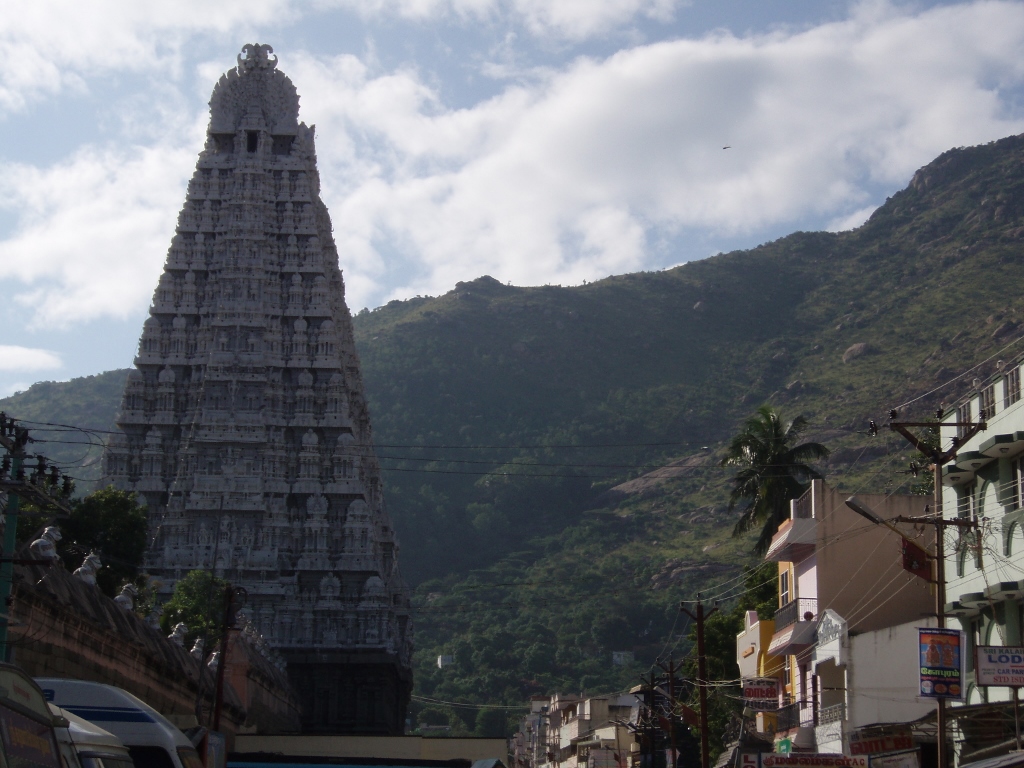 One of the perimeter gopurams of Arunachaleshvara Temple with mountain Arunachala in the background
One of the perimeter gopurams of Arunachaleshvara Temple with mountain Arunachala in the background
Close to this very important temple we passed through something that seemed like a market, but there were also scaffolds that carried a canopy. We presumed that some important procession related to the festival had passed there, but there was nobody to ask whom we could also understand.
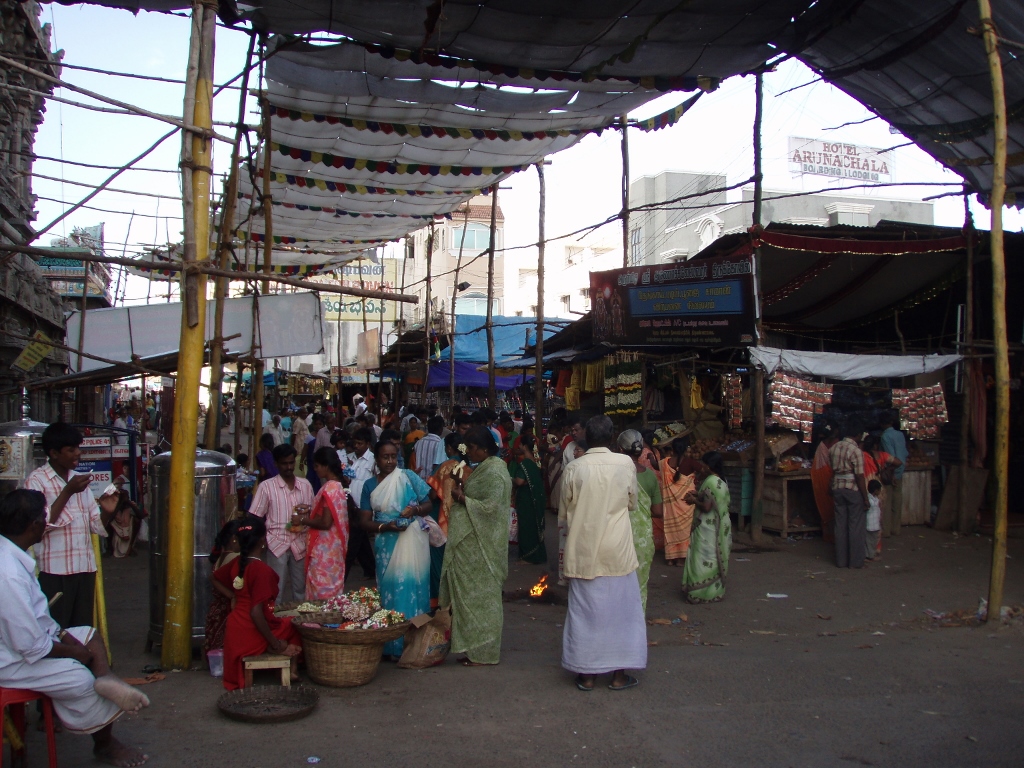 Surroundings of Arunachaleshvara Temple
Surroundings of Arunachaleshvara Temple
Not only is it very important, Arunachaleshvara Temple is also enormous. This temple complex spreads across the area of around ten hectares which puts it among the biggest temples in India.
The complex is surrounded by walls and on each of the cardinal points there is one whitish gopuram, a monumental tower that rises above the gate. The gopuram on the east side, 66 metres high is the highest gopuram in India among those that were not built in the 20th or the 21st century. In addition, the gopurams in the north (52 m) and south (48 m) are also among the highest in the country. Within the complex itself there are a few smaller gopurams.
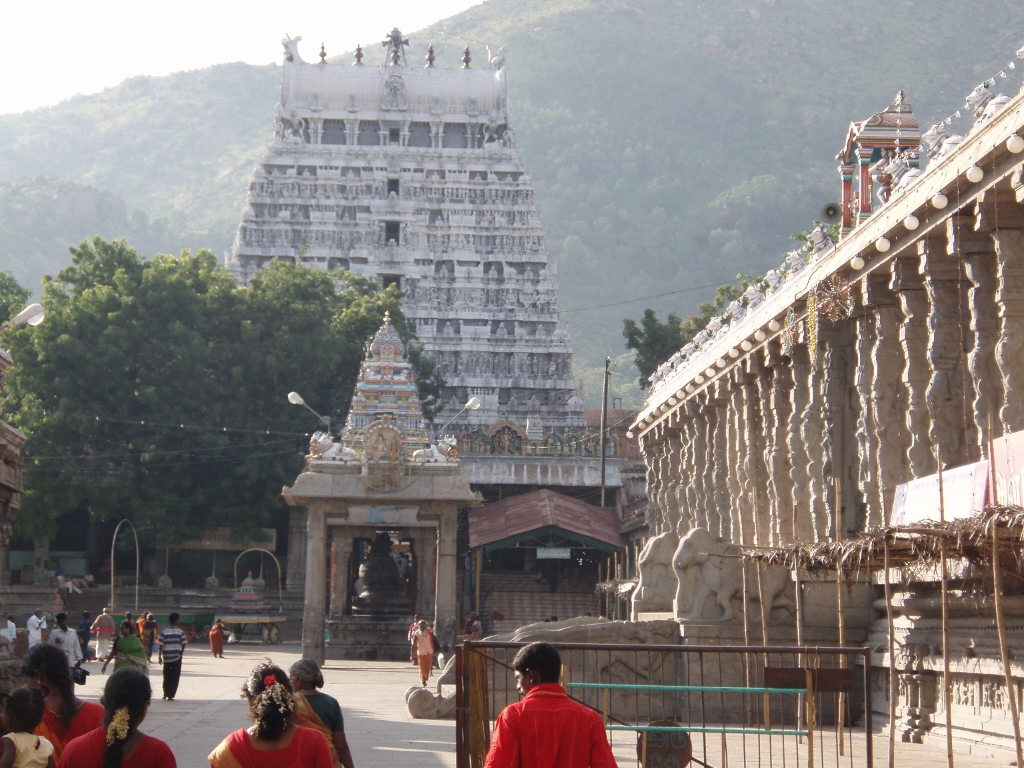 One of the smaller gopurams within the Arunachaleshvara Temple Complex
One of the smaller gopurams within the Arunachaleshvara Temple Complex
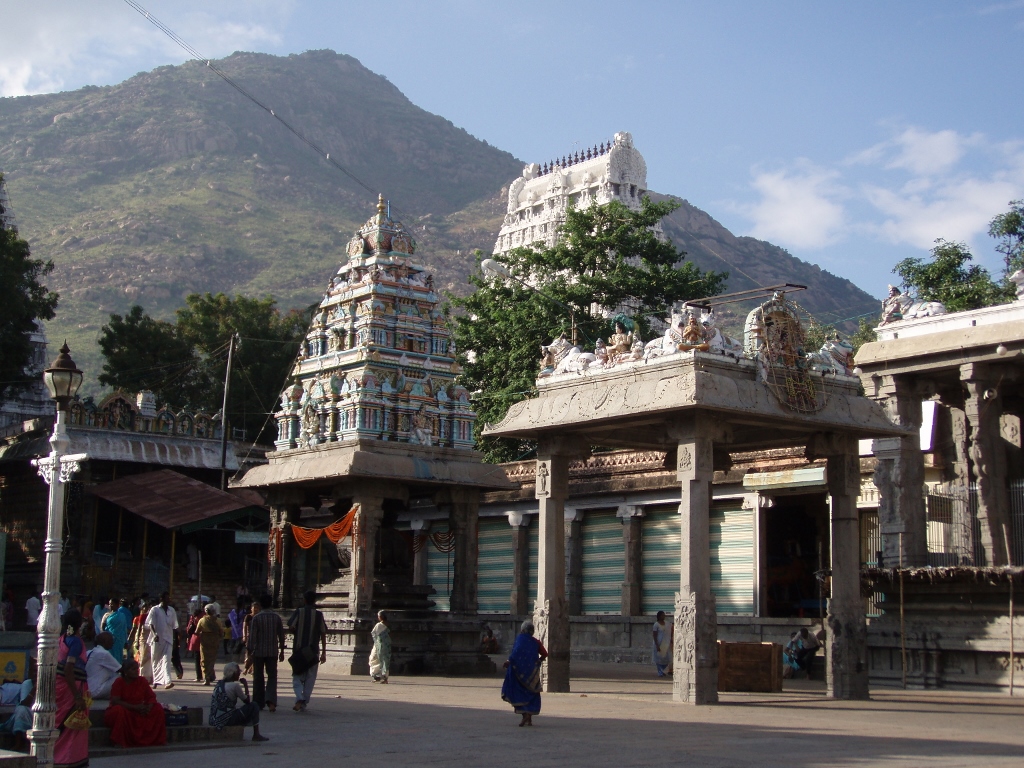 View at the top of the north gopuram and Arunachala mountain
View at the top of the north gopuram and Arunachala mountain
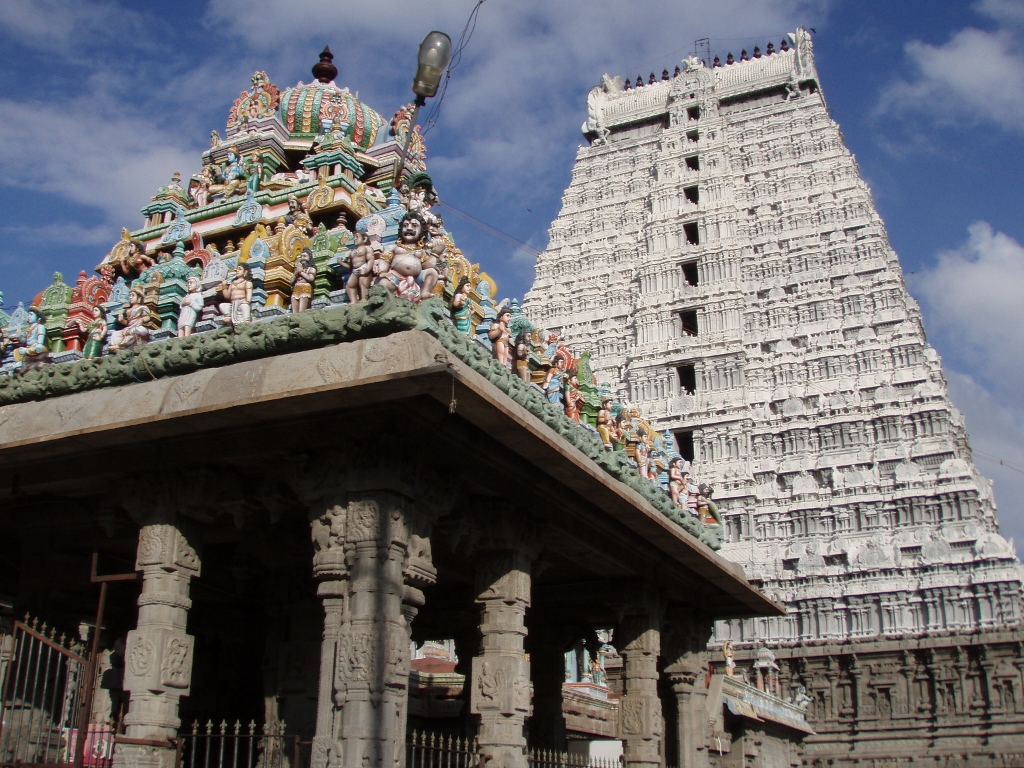 View at a smaller shrine and the east gopuram
View at a smaller shrine and the east gopuram
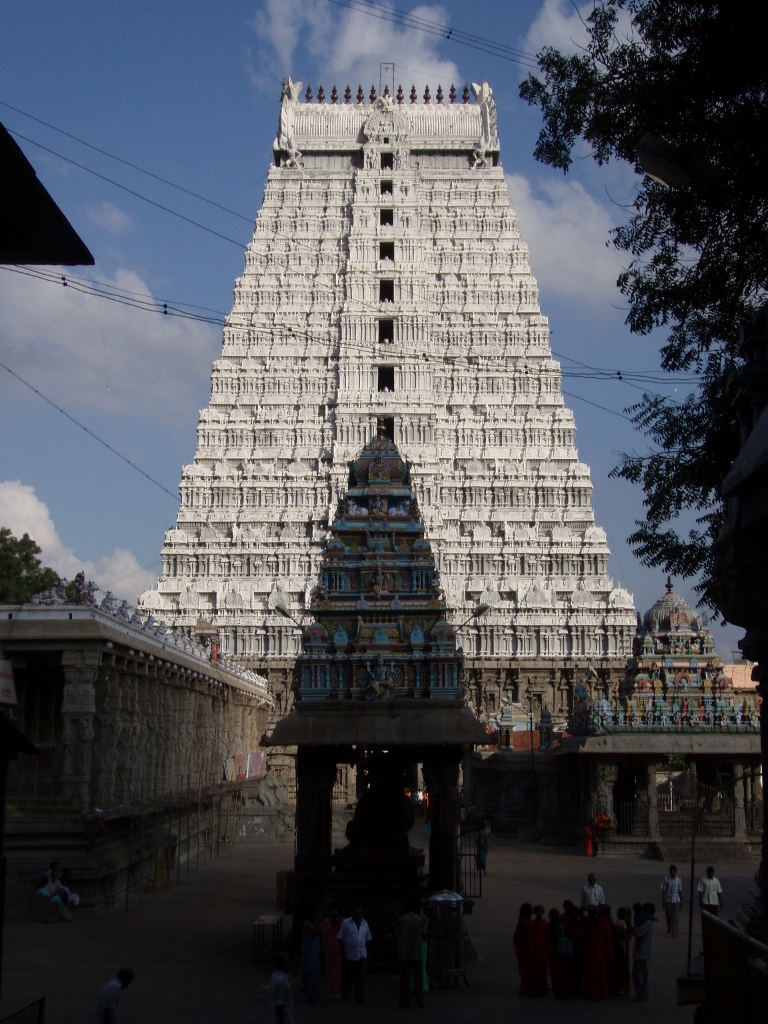 Temple complex is accessed through the east gate
Temple complex is accessed through the east gate
In that first inner courtyard that we entered, there was a pavilion with Nandi, the sacred bull. I have already mentioned before, but as a reminder – Nandi is the deity that guards the gates leading to the holy mountain Kailasa where god Shiva resides and if necessary Nandi is also Shiva’s mount. As it may be seen in the photo below, the Hindus love to decorate the symbolic representations of their deities additionally using paints.
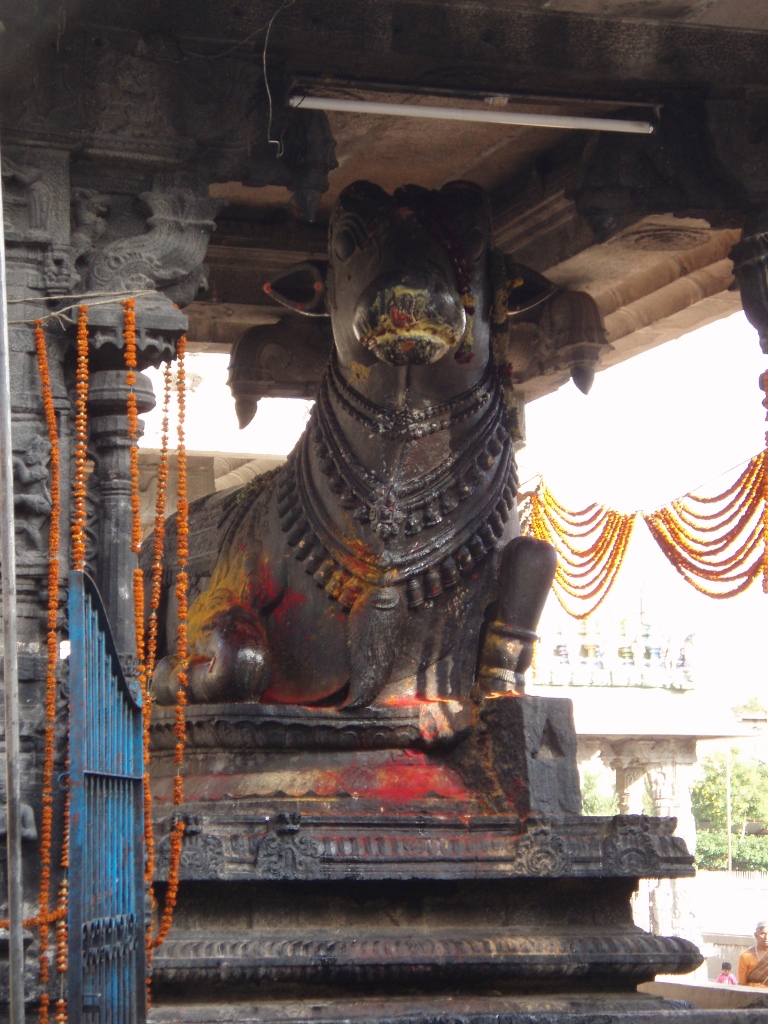 Bull Nandi in his pavilion
Bull Nandi in his pavilion
But it was not only Nandi that was decorated on this day. While we were moving from one inner courtyard to the next, beside some pillars we saw an elephant that was also “made up.” On his forehead he wore a sign that is called tripundra and that is linked to the worshipping of Shiva.
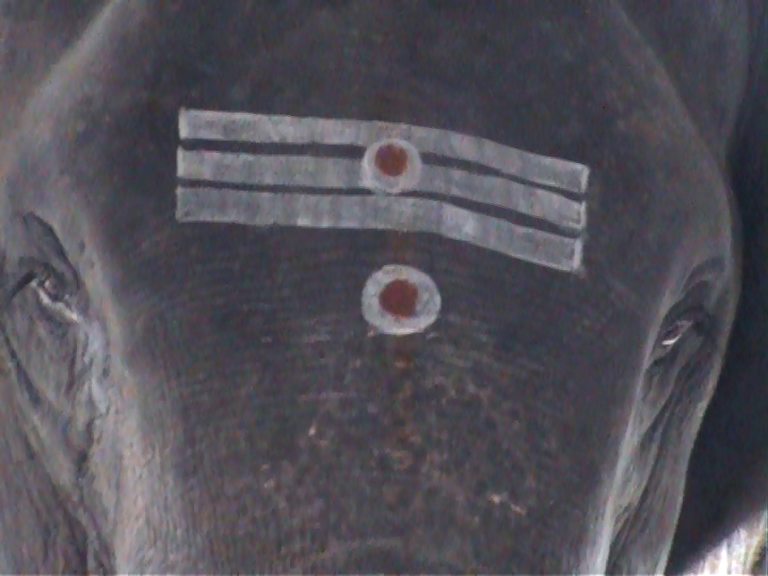 Elephant with a tripundra on its forehead
Elephant with a tripundra on its forehead
Admittedly, everything in this temple, like in all of India, was picturesque.
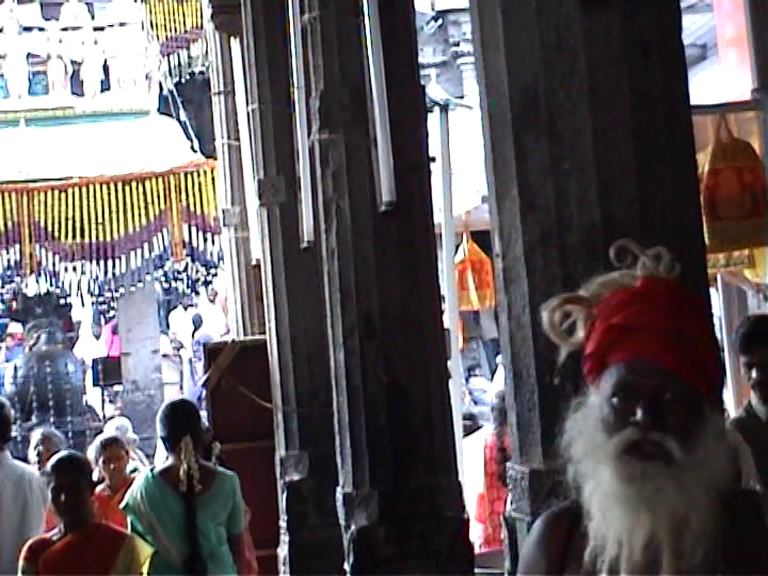 Images from the Arunachaleshvara Temple Complex
Images from the Arunachaleshvara Temple Complex
There are six daily rituals that take place at the temple and while we were leisurely walking around the courtyard, the believers had already taken up their places in front of the entrance into the main section.
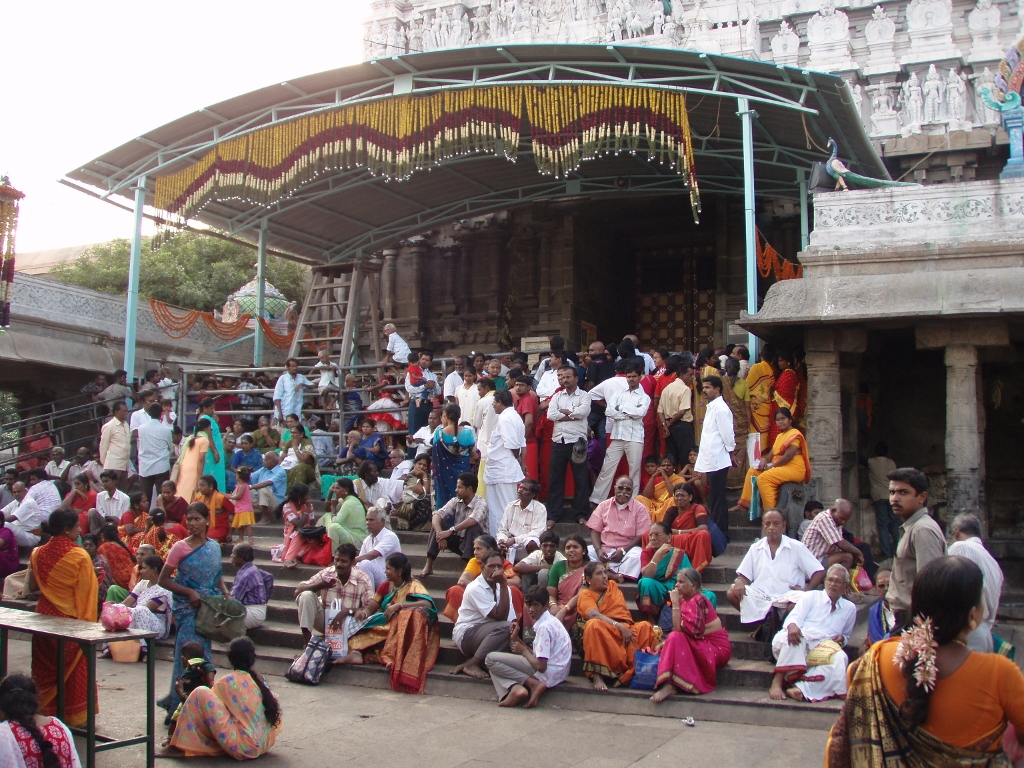 Waiting at the stairs
Waiting at the stairs
Both Sneža and I noticed that many visitors to this temple, mostly women, were dressed in brightly red clothes, which we connected with Shiva as the fiery pillar and the symbolism of red colour of the element of fire. From the moment we entered the temple complex we were joined, in the capacity of an unofficial and unsolicited guide, by a boy who seemed very polite, but his English was still limited enough that he could neither confirm nor rebut our theory. In any case, he told us that there was no festival of any kind at the temple, but just an ordinary day.
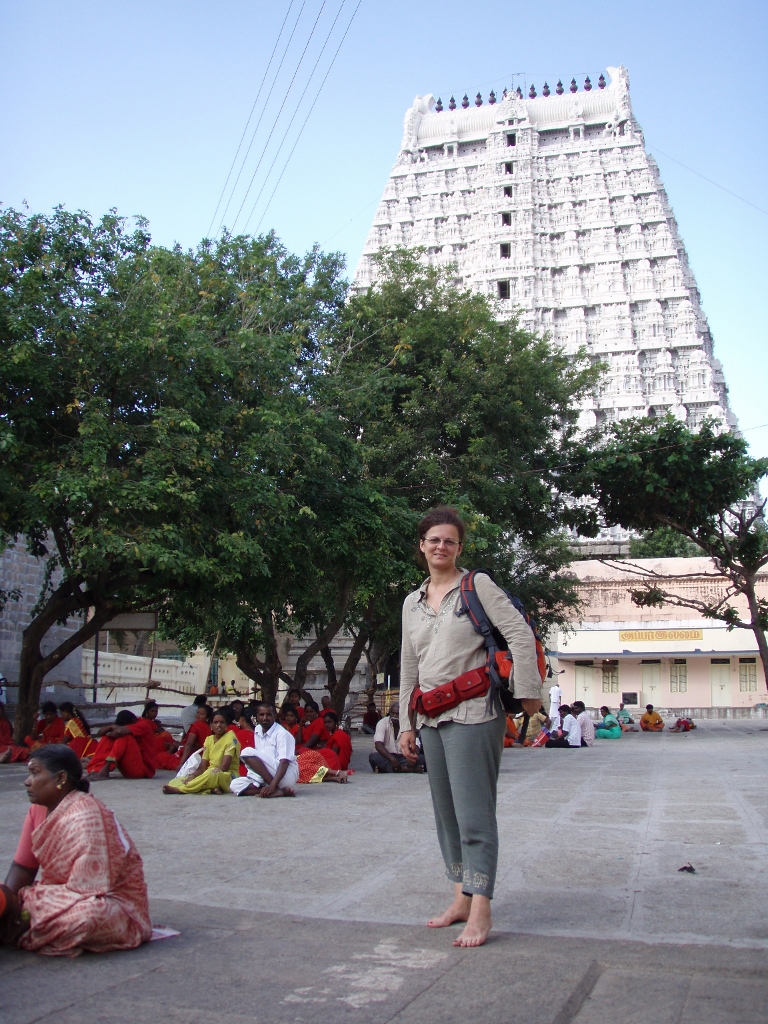 Sneža in one of the inner courtyards of the temple; note the people sitting in the background who are mostly dressed in red
Sneža in one of the inner courtyards of the temple; note the people sitting in the background who are mostly dressed in red
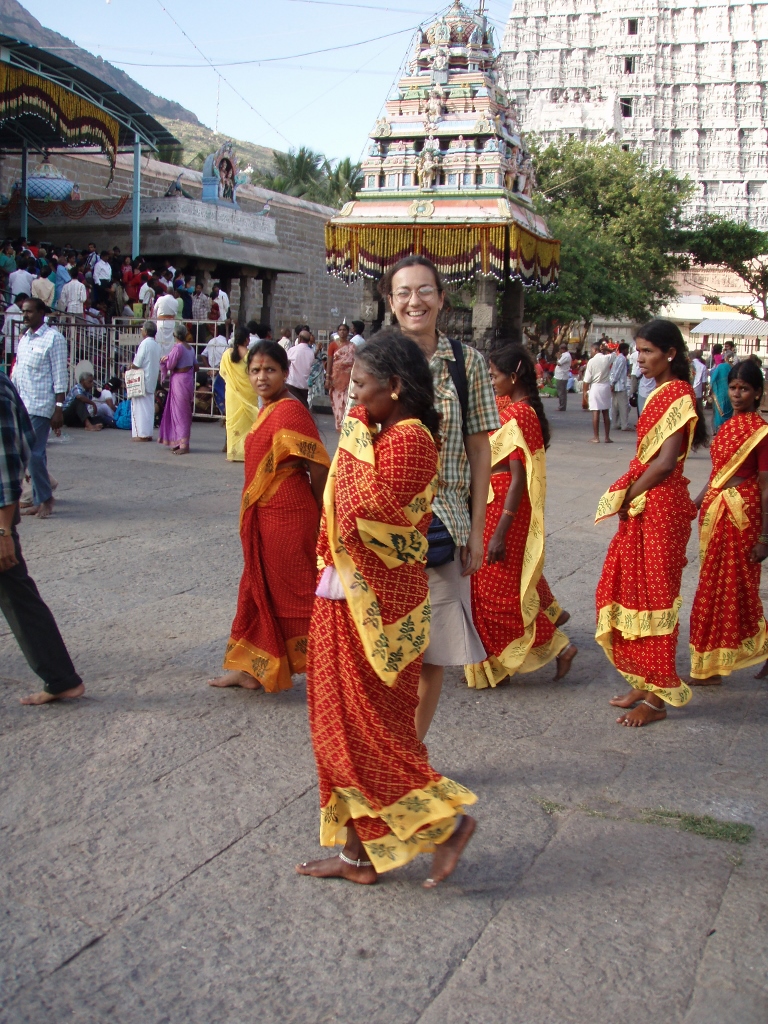 Me in one of the inner courtyards of the temple
Me in one of the inner courtyards of the temple
Back in Kochi I bought for myself a silver anklet. Just like that. Since I was in India, I found it interesting. Somehow it happened that on this day I decided to wear it around my right ankle. While we were walking around the temple, quite a large number of women approached me, saying something and pointing at that anklet. It was obvious that something in that was catching their eye. Of course, again there was nobody to consult what this was about, but in order to reduce the attention I drew to myself with that object, I simply took it off. Later, back at home, I tried to wear it sometimes as an ornament, but I realised it did not fit my leg quite well, so that anklet is now just sitting idly in one of the jewellery boxes.
Within the temple complex we also went to see a tank, Brahma Theertham, and then we moved slowly towards the exit.
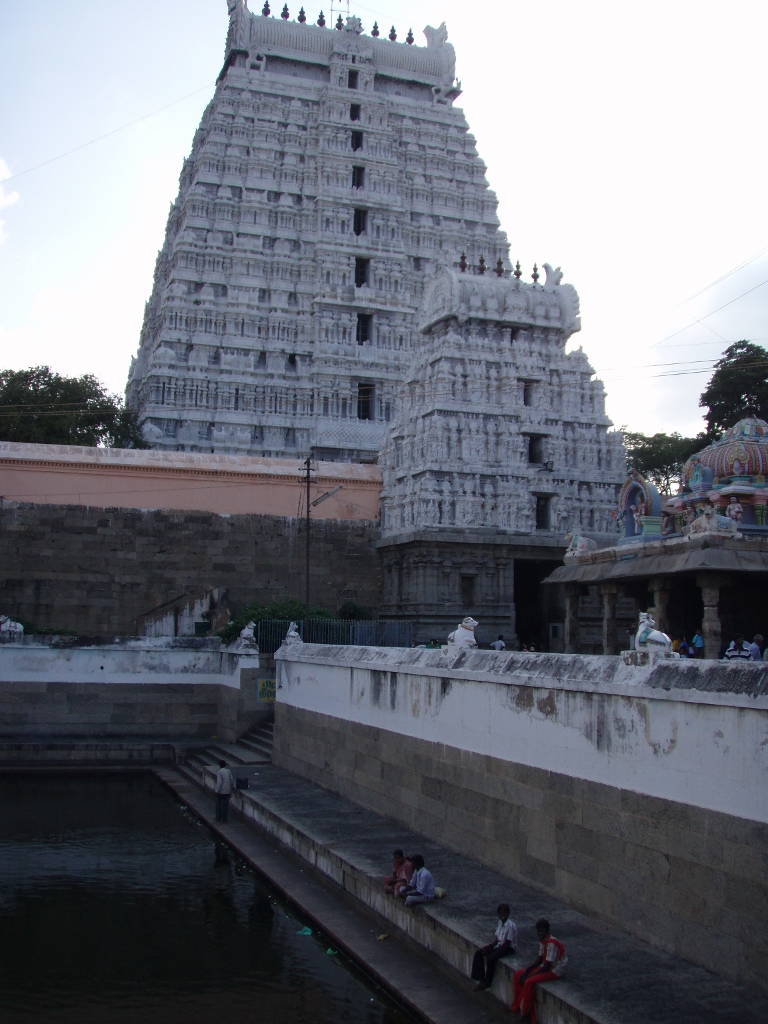 Part of the Brahma Theertham tank and southern gopuram
Part of the Brahma Theertham tank and southern gopuram
Getting back to the part of the market that surrounds Arunachaleshvara Temple in Tiruvannamalai, we saw several wooden temple chariots. They are extremely vibrantly decorated – large colourful wheels, opulent woodcarving and then other vivid parts that constitute the body of the chariots – these vehicles that carry symbols of the Hindu gods during celebrations and festivals are very important and there is practically an inventory list as to how many there are, for instance, in the state of Tamil Nadu, which temples own chariots like this, what state they are in, etc.
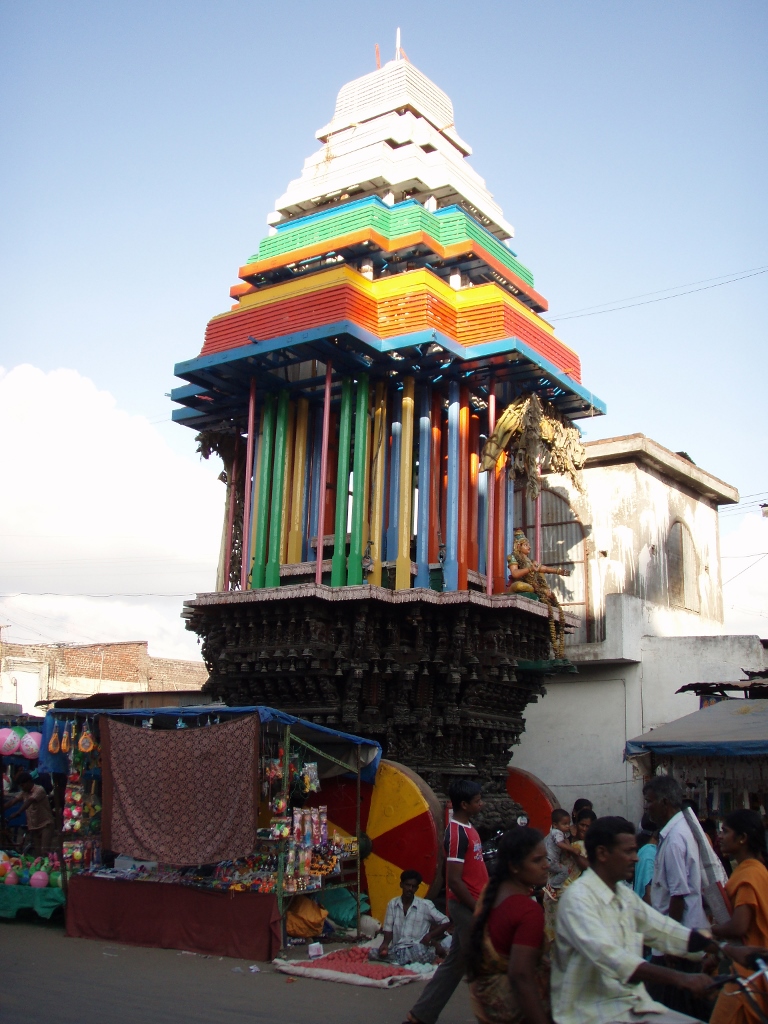 Temple chariot that belongs to Arunachaleshvara Temple in Tiruvannamalai
Temple chariot that belongs to Arunachaleshvara Temple in Tiruvannamalai
After this we were ready to go back to Puducherry. Sneža did not particularly like either Tiruvannamalai or Arunachaleshvara Temple, but for me they were quite all right. The temple was remarkable in its own way, while all the other images and impressions that came with it and its surroundings were very much Indian – the crowds, the colourfulness, the dust, the litter, the beggars, the smell ...
And as for the return to Puducherry for the night? Well, that was yet another one of the terrifying mad drives.
The next day we went for a walk again and this time we also had breakfast at a café that was promoted a lot, but proved to be quite a disappointment, so afterwards we returned to the boarding house, took our luggage and went to the coach station. After 15-20 minutes of wandering around the station caused by unclear instructions, we finally settled into a local express coach to Chennai that was scheduled to pass close to a place called Mamallapuram. The coach seemed to rush like crazy, although it probably did not drive more than 70 km/h, but it did drive like a maniac. The driver just kept pressing the horn and stepping on the gas pedal, continuously performing reckless overtaking, etc. In the end, Sneža and I just smiled in our disbelief and powerlessness.
When we got off the coach, we caught an auto rickshaw and went to our hotel. In the centre of the small town we passed by numerous shops with colourful goods typical of India and Sneža’s eyes just glittered with potential and expected joy associated with shopping.
Still, we first settled at the hotel and then went for lunch at a fine restaurant beside the beach. It was only afterwards that we went on foot to visit what is important in this little town. By the way, Mamallapuram has two names. The other one is Mahabalipuram, but in the text I’m going to use the former; first because I’m used to it and second because I don’t know the explanation for the latter one.
Namely, Mamallapuram used to be an important port on the shore of the Bay of Bengal and there, in the 7th century, the town was founded by King Narasimha Varman I (ruled in the period 630-668) who belonged to the Pallava dynasty. His nickname was Mamallan which means Great Wrestler and thus the town was named after its founder.
Mamallapuram is inscribed in the UNESCO’s World Heritage List because of a group of religious monuments that originate back to the 7th and the 8th centuries CE. Since the two of us had already had the lunch near the beach, we took this opportunity and first went to visit the Shore Temple, one of the masterpieces within this group.
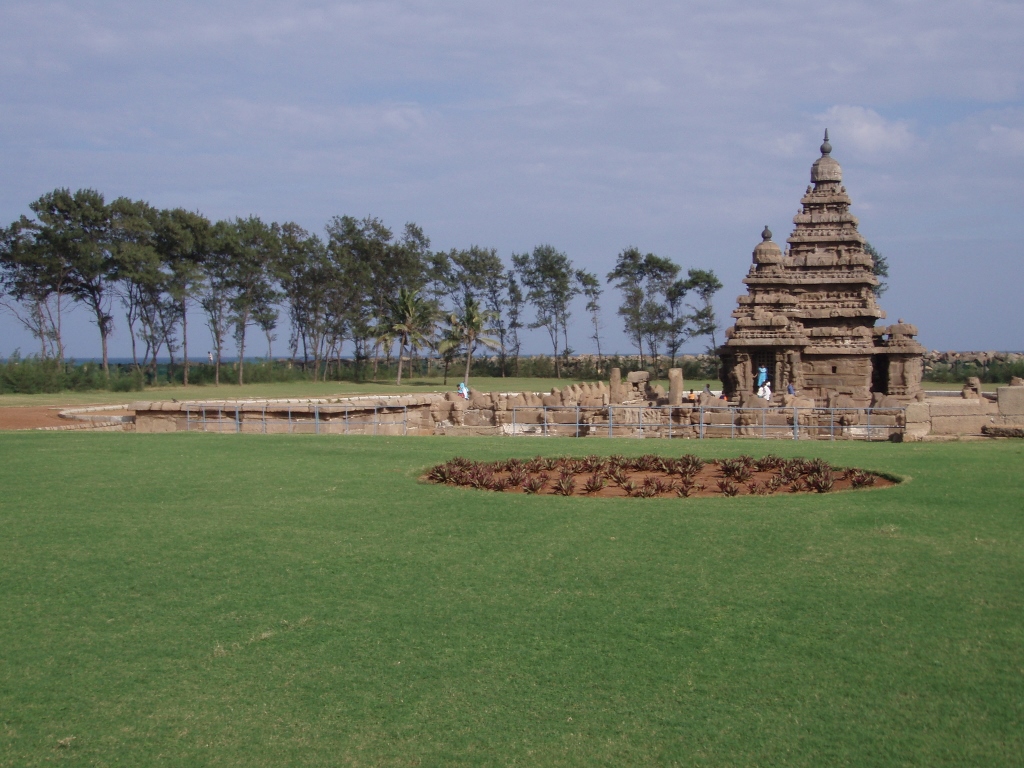 Shore Temple
Shore Temple
The Shore Temple is called like that simply because of its position. This, too, actually refers to a temple complex which incorporates three temples, the main one being dedicated to Shiva.
This entire area is famous for stone carving. Namely, the artists and craftsmen from Mamallapuram have always worked hard at emulating carving that can otherwise be made in wood, which is exceptionally difficult. A large number of temples and shrines in this place are in fact spaces carved out in the rock, while the Shore Temple is one of the few “structural” temples, meaning it has a structure, i.e., it was constructed and not carved out in the rock.
Although small by its proportions, this temple from the beginning of the 8th century is very opulently decorated, but because of the specific position on the shore where it is exposed to the natural elements it has also eroded so all those decorations seem somehow rounded-up, as if they were melting.
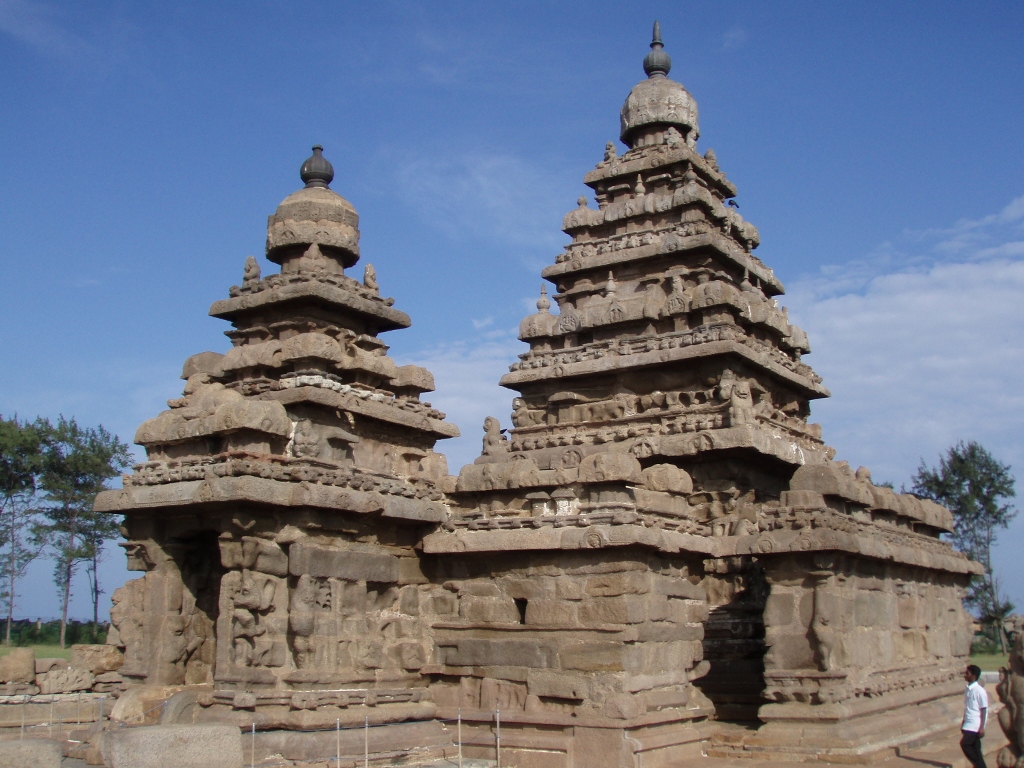 Shore Temple
Shore Temple
In 2004, the shores of the Bay of Bengal were hit by a catastrophic tsunami and this temple was inundated, but the damage was not too big. On the other hand, on that occasion, when the water receded, it was noticed that on the bottom of the bay there were remains of some other temples and it is presumed that these could possibly be the ruins of the so-called “Seven Pagodas” as the Europeans from Marco Polo on used to call this area on account of seven temples that were built on its shore. With time, the shore was submerged and today only the Shore Temple may be seen.
But, in addition to these three temples, this entire small complex is also filled and decorated with numerous sculptures and smaller shrines.
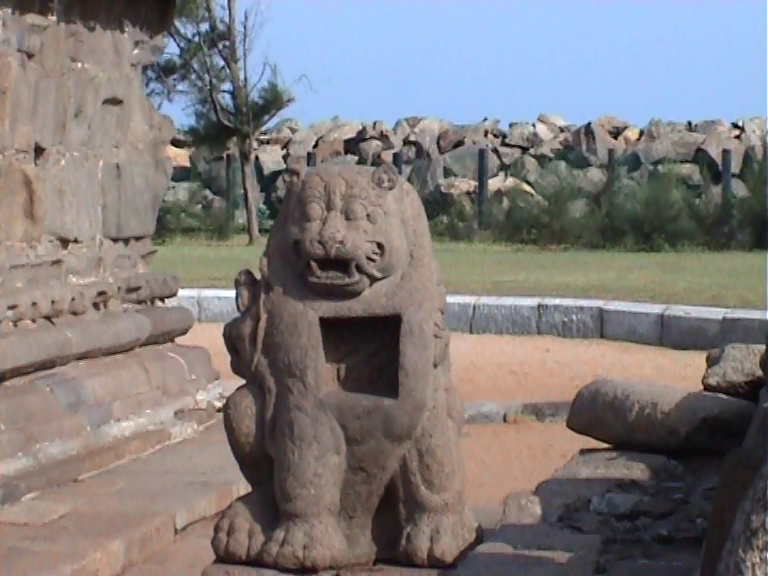 Sculpture of a lion in the square recess of which there is carved depiction of goddess Durga
Sculpture of a lion in the square recess of which there is carved depiction of goddess Durga
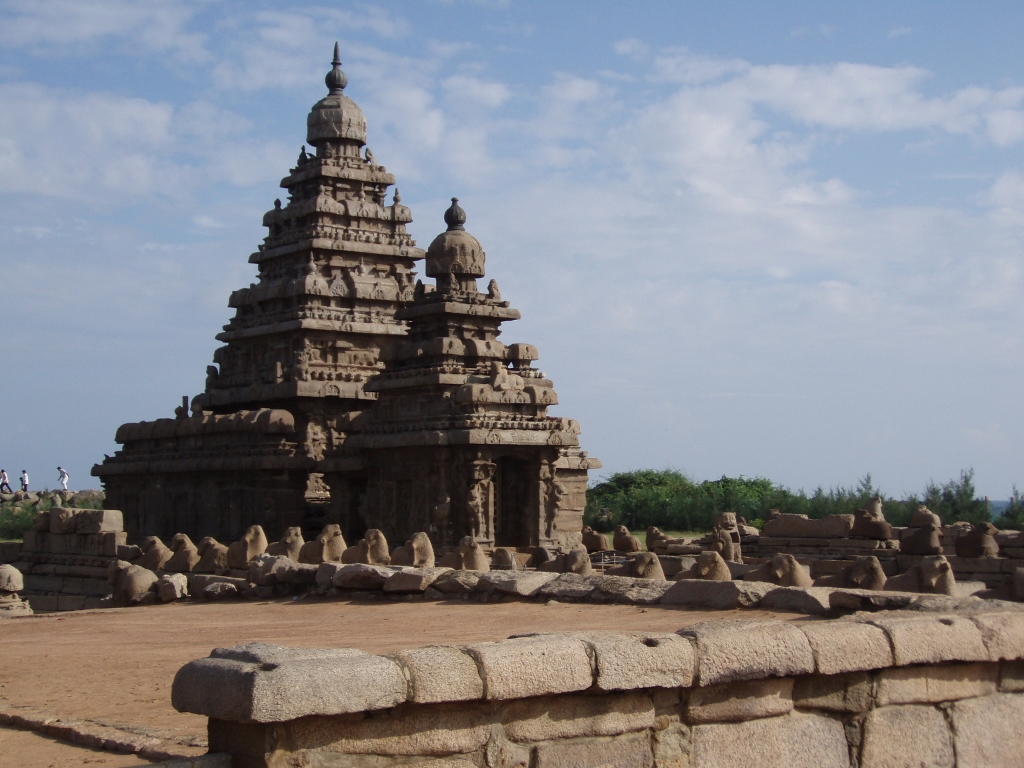 Shore Temple with numerous stone Nandi bulls that adorn the perimeter walls
Shore Temple with numerous stone Nandi bulls that adorn the perimeter walls
Then we walked to the centre of the small town that really looks more like a village and for the Indian standards it is a very small place indeed since it has only a little over 15,000 residents (data from 2011).
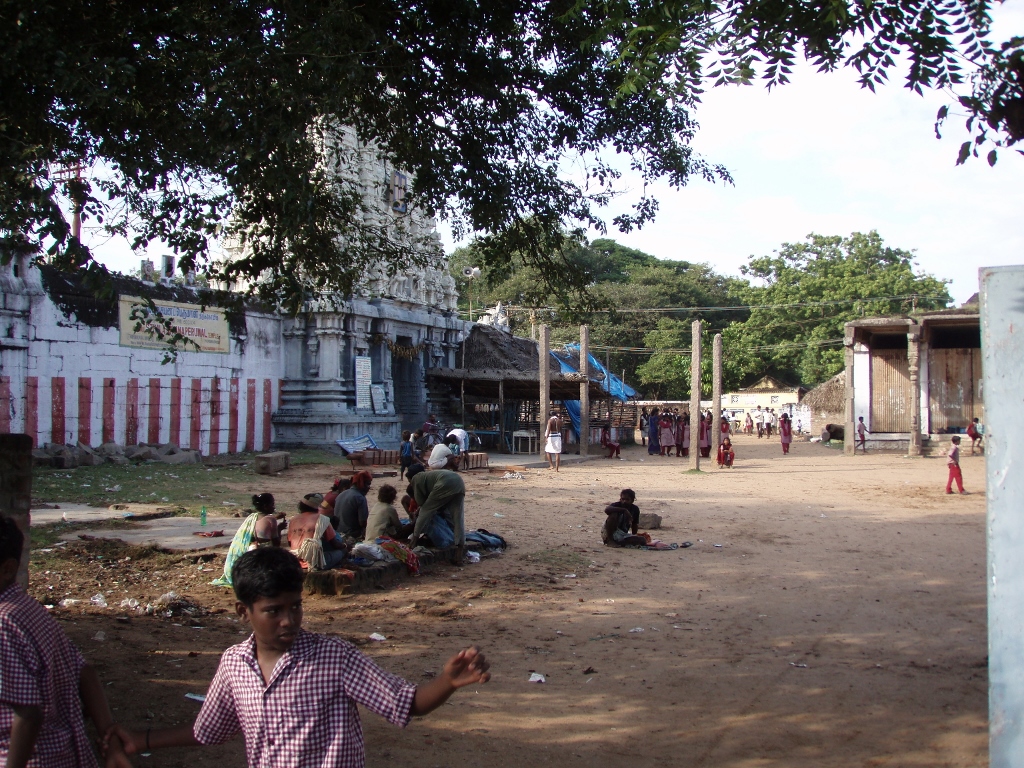 Streets in Mamallapuram
Streets in Mamallapuram
And then we came to a proper masterpiece.